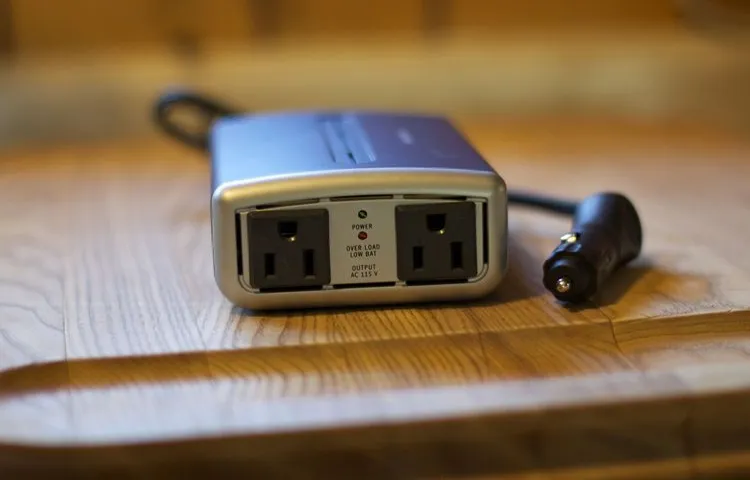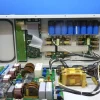If you’ve ever found yourself in a situation where you needed to convert DC power to AC power, then a power inverter is the device you need. But what exactly is a power inverter and how does it work? Well, imagine you’re in the middle of a camping trip and you want to charge your phone or run some small appliances. However, you don’t have access to an electrical outlet.
This is where a power inverter comes in handy. It essentially takes the DC power from a battery or a generator and converts it into AC power, allowing you to use your electronic devices and appliances. Think of it as a translator between the world of DC power and the world of AC power.
Just like a translator helps you communicate with someone who speaks a different language, a power inverter helps you bridge the gap between the DC power source (like a battery) and the AC power needed to run your devices. It takes the electrical current and changes its form, so you can power up your laptop, charge your camera, or even run a mini fridge while on the go. Power inverters come in various sizes and power capacities, depending on your needs.
Some are small enough to fit in your car’s glove compartment, while others are designed to power an entire RV or a remote cabin. They also come with different features, such as multiple outlets, USB ports, and built-in safety measures to protect your devices from power surges. So, whether you’re a frequent traveler, a camper, or just someone who occasionally needs to power up their electronics without an electrical outlet, a power inverter is a must-have device.
It allows you to stay connected and enjoy the comforts of modern technology wherever you go. So, next time you find yourself in a situation without access to AC power, remember that a power inverter is your solution to stay powered up and connected.
Table of Contents
- 1 Why would you want a power inverter in your car?
- 2 What do you need to install a power inverter?
- 3 Step 1: Choose the right power inverter for your needs
- 4 Step 2: Find a suitable location for the power inverter
- 5 Step 3: Connect the power inverter to the car battery
- 6 Step 4: Secure the power inverter in place
- 7 Step 5: Test the power inverter
- 8 Conclusion: Enjoy the benefits of a power inverter in your car
- 9 FAQs
Why would you want a power inverter in your car?
If you find yourself frequently needing to power electronic devices while on the go, installing a power inverter in your car could be the perfect solution. A power inverter allows you to convert DC power from your car’s battery into AC power, providing you with a convenient source of electricity for charging laptops, powering small appliances, or even running tools. Imagine being able to work on your laptop or enjoy a movie with a portable DVD player during a long road trip, all without worrying about your device’s battery running out.
By installing a power inverter in your car, you can transform your vehicle into a mobile power station, increasing your convenience and productivity on the road.
What do you need to install a power inverter?
Installing a power inverter in your car is a convenient way to power your electrical devices while on the go. To get started, you’ll need a few key items. First, you’ll need a power inverter itself, which can be found at most automotive stores.
Make sure to choose an inverter that matches your power needs and vehicle’s electrical system. Next, you’ll need a set of high-quality cables to connect the inverter to your car’s battery. These cables should be thick enough to handle the power load without overheating.
You’ll also need a fuse and fuse holder to protect your electrical system from overload. Additionally, it’s important to have basic tools such as screwdrivers and wire cutters on hand to properly install the inverter. Lastly, it’s a good idea to have some electrical tape or heat shrink tubing to secure the connections and prevent any accidental short circuits.
With these items in hand, you’ll be well-equipped to install a power inverter and enjoy the convenience of powering your devices while on the road.

Step 1: Choose the right power inverter for your needs
Installing a power inverter in your car can be a great way to have access to AC power while on the go. But before you start the installation process, it’s important to choose the right power inverter for your needs. Power inverters come in different sizes and wattages, so it’s crucial to choose one that matches the devices you plan to power.
If you only need to charge small electronic devices like smartphones or laptops, a smaller inverter with a lower wattage will suffice. However, if you plan to power larger appliances like a mini-fridge or a power tool, you’ll need a higher wattage inverter. So, before you begin the installation process, make sure to check the power requirements of the devices you want to power and choose an inverter accordingly.
By selecting the right power inverter, you’ll ensure that you have enough power to run your devices effectively while on the road.
Step 2: Find a suitable location for the power inverter
So, you’ve decided to install a power inverter in your car to charge all your electronic devices on the go. That’s a smart move! Now, the next step is to find a suitable location for the power inverter. You want to make sure it’s easily accessible and won’t interfere with your driving or any other components of your vehicle.
One common and convenient location is under the front passenger seat. This allows for easy access and keeps the inverter out of sight. Another option is in the center console or glove box, if there’s enough space.
Just make sure the inverter is securely mounted and doesn’t move around while driving. Whichever location you choose, remember to consider factors like ventilation and accessibility to the power source. By finding the perfect spot for your power inverter, you’ll be well on your way to enjoying a fully charged car ride.
Step 3: Connect the power inverter to the car battery
Now that you have your power inverter and tools ready, it’s time to connect it to your car battery. First, locate your car’s battery, which is usually found under the hood or in the trunk. Before proceeding, make sure your car is turned off to avoid any accidents.
Next, identify the positive and negative terminals on the battery. The positive terminal is usually marked with a plus (+) sign, while the negative terminal is marked with a minus (-) sign. Connect the positive wire from the power inverter to the positive terminal of the battery and tighten it securely.
Then, connect the negative wire from the inverter to the negative terminal of the battery. Again, ensure that the connection is tight. Once everything is connected, double-check your connections to make sure they are secure and there are no loose wires.
Finally, you can turn on your car and test your power inverter to ensure it is working properly.
Step 4: Secure the power inverter in place
Now that you’ve chosen the perfect location for your power inverter, it’s time to secure it in place. This step is crucial to ensure that the inverter stays in position and doesn’t move around while you’re driving. One common method of securing the power inverter is to use screws or bolts.
You’ll need to drill holes into the surface where you want to mount the inverter and then attach it using the screws or bolts. Make sure to measure and mark the exact placement of the holes beforehand to avoid any mistakes. Another option is to use adhesive tape or Velcro straps.
This method is less permanent and allows for easier removal if needed. Simply attach the tape or straps to the back of the inverter and then stick it to the desired location in your car. Whichever method you choose, make sure that the power inverter is tightly secured and won’t move around while you’re driving.
Step 5: Test the power inverter
So, you’ve gone through the process of purchasing and mounting your power inverter in your car. Now it’s time to put it to the test and see if it’s working properly. Testing the power inverter is an important step to ensure that it is installed correctly and will provide the desired power output.
To test the power inverter, start by connecting it to your car’s battery. Make sure the inverter is switched off before connecting the cables. Once the connections are secure, switch on the inverter and check if the indicator light or LCD display lights up.
This is a good sign that the inverter is receiving power from the battery. Next, plug in a small electronic device, such as a phone charger or laptop charger, into one of the outlets on the inverter. If the device starts charging or powering on, then the power inverter is functioning properly.
You can also try plugging in multiple devices at once to test the inverter’s capability to handle multiple loads. During the testing process, it’s important to pay attention to any unusual sounds or smells coming from the power inverter. If you notice any strange noises or burning smells, immediately switch off the inverter and disconnect it from the battery.
This could indicate a short circuit or other malfunction, and it’s best to have a professional inspect and repair the inverter. By properly testing the power inverter, you can have peace of mind knowing that it is installed correctly and will provide the necessary power for your electronic devices while on the road. Now you can continue on your journey with confidence, knowing that you have the convenience of a power source in your car.
Conclusion: Enjoy the benefits of a power inverter in your car
In conclusion, installing a power inverter in your car is like giving your vehicle a superpower. It’s like turning your trusty four-wheeled companion into a mobile fortress of energy. With a witty installation process that involves a dash of know-how and a sprinkle of cleverness, you’ll be harnessing the untapped potential of your car’s electrical system in no time.
By following our step-by-step guide, you’ll be able to tap into the raw power of your car’s battery and transform it into a source of electricity that can rival the mightiest of superheroes. Whether you’re charging your laptop on a spontaneous road trip, powering up your mini-fridge to keep your sodas frosty, or even operating power tools at a remote construction site, the possibilities are as endless as your imagination. Just remember to choose the right size of power inverter for your needs, connect it to the battery using the trusty method we’ve laid out, secure everything in place with the precision of a master puzzle-solver, and voila! Your car will be transformed into a veritable mobile power station.
So, why settle for a regular old car when you can have a car that’s also a secret superhero lair? With a power inverter installed, your vehicle will rise above the mundane and become a symbol of electrifying awesomeness. So, go forth, fellow car enthusiasts, and let your cars roar with the might of thunder and the brilliance of lightning – all thanks to the power inverter in your capable hands.”
FAQs
What is a power inverter and what does it do?
A power inverter is a device that converts DC (direct current) power from your car’s battery into AC (alternating current) power that can be used to run electronic devices.
How do I choose the right power inverter for my car?
When choosing a power inverter for your car, consider the wattage requirements of the devices you plan to use, the input voltage of your car’s battery, and any additional features you may need such as USB ports or surge protection.
Can I install a power inverter in any car?
Power inverters can be installed in most cars as long as they have a 12V DC system. However, it is always recommended to check your car’s manual or consult with a professional to ensure compatibility and proper installation.
Where should I install a power inverter in my car?
Power inverters are typically installed in the trunk or under the seats of a car. It is important to choose a location that is easily accessible for wiring and ventilation to prevent overheating.
Is it safe to leave a power inverter plugged in when the car is turned off?
It is generally recommended to unplug the power inverter when the car is turned off to avoid draining the car battery. However, some power inverters have built-in low voltage protection and will automatically shut off when the battery voltage drops too low.
Can I use a power inverter while driving?
Yes, you can use a power inverter while driving to power devices such as laptops or portable chargers. It is important to securely mount the power inverter and ensure all cables are properly connected to avoid distractions while driving.
How do I properly wire a power inverter in my car?
Properly wiring a power inverter in your car involves connecting the positive and negative cables to the battery terminals and using an appropriate fuse or circuit breaker for overcurrent protection. It is recommended to follow the manufacturer’s instructions or consult with a professional for proper wiring procedures.


